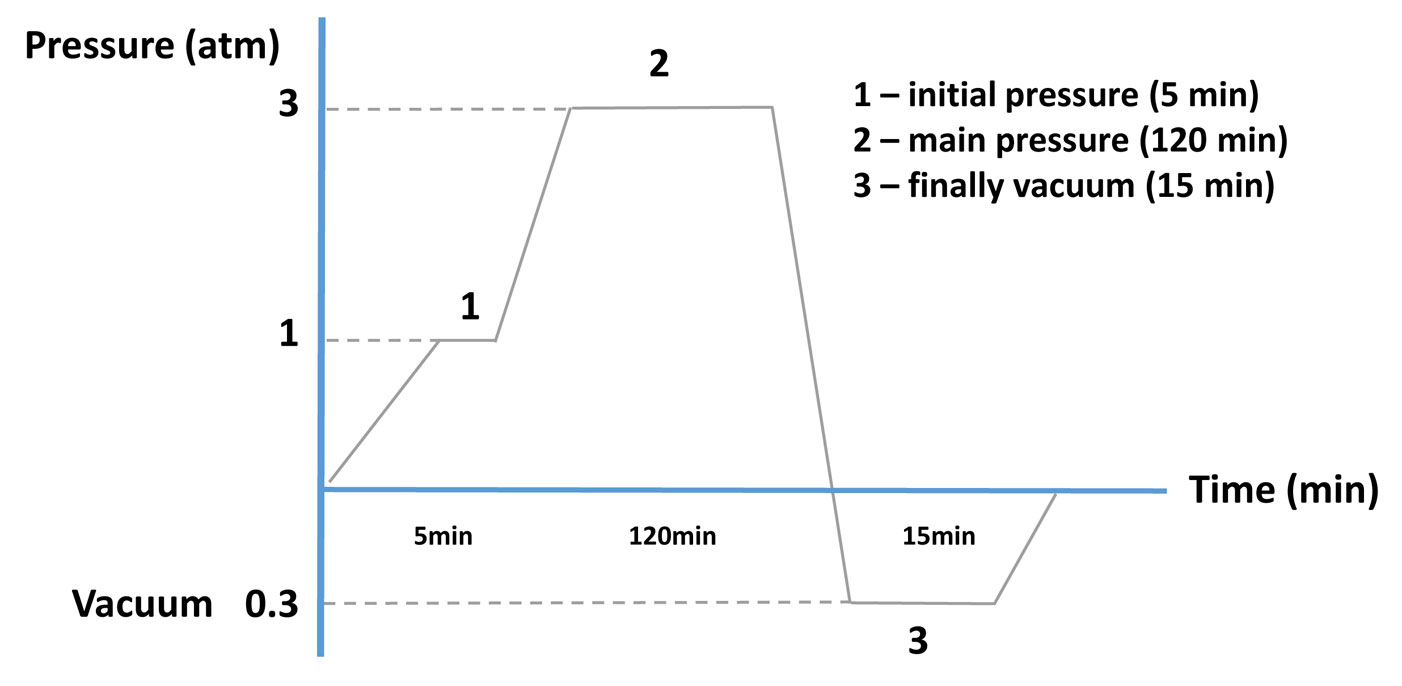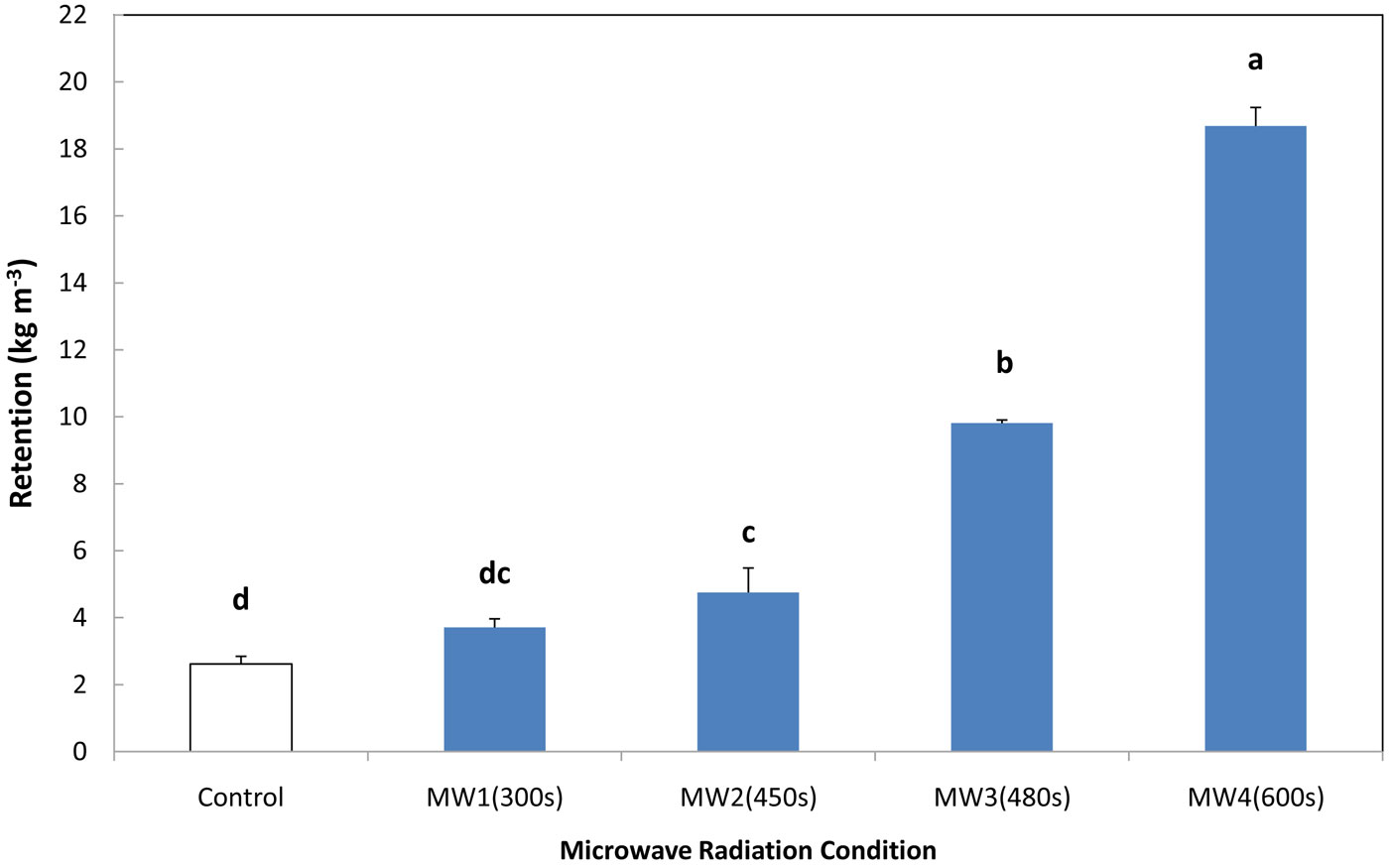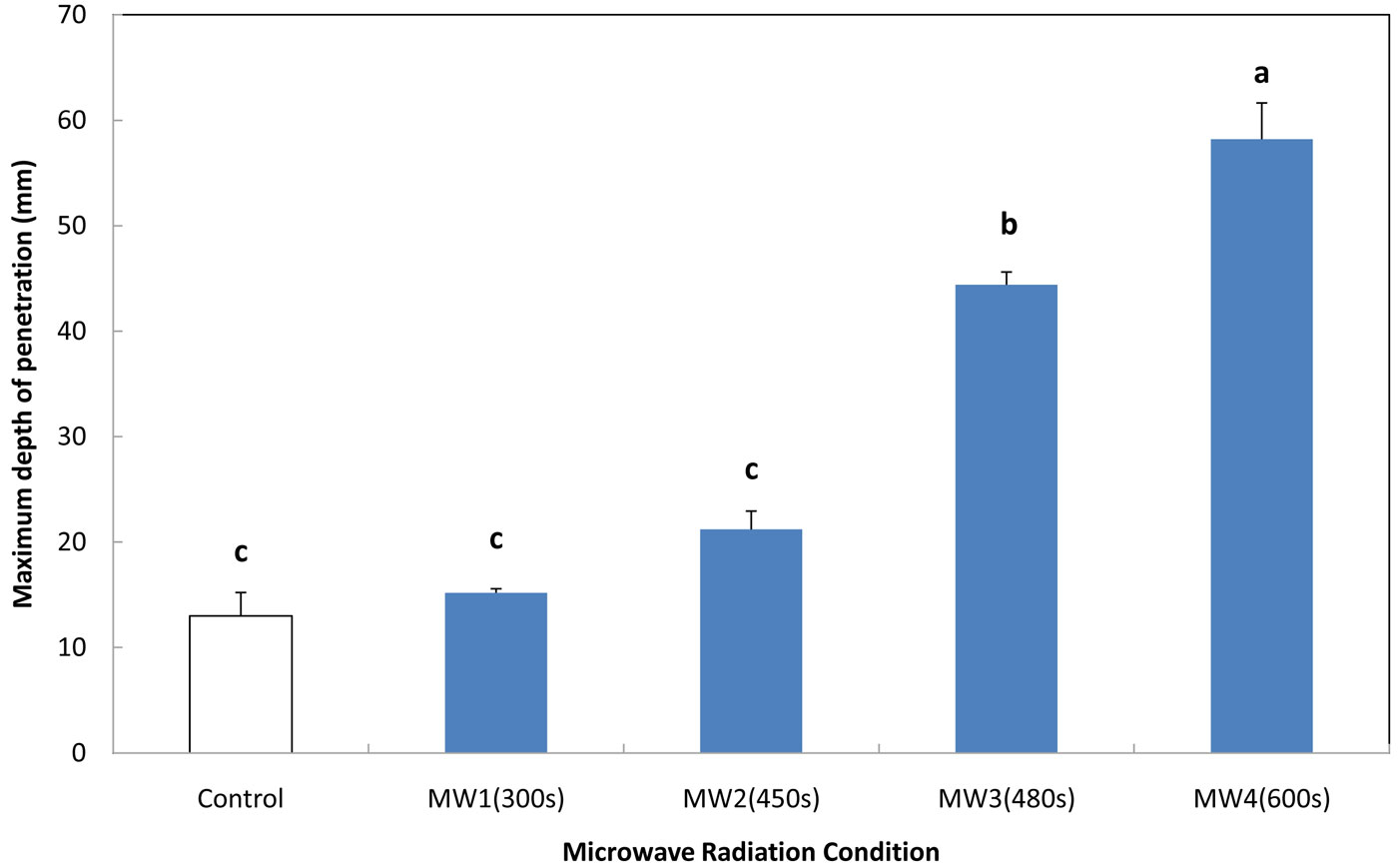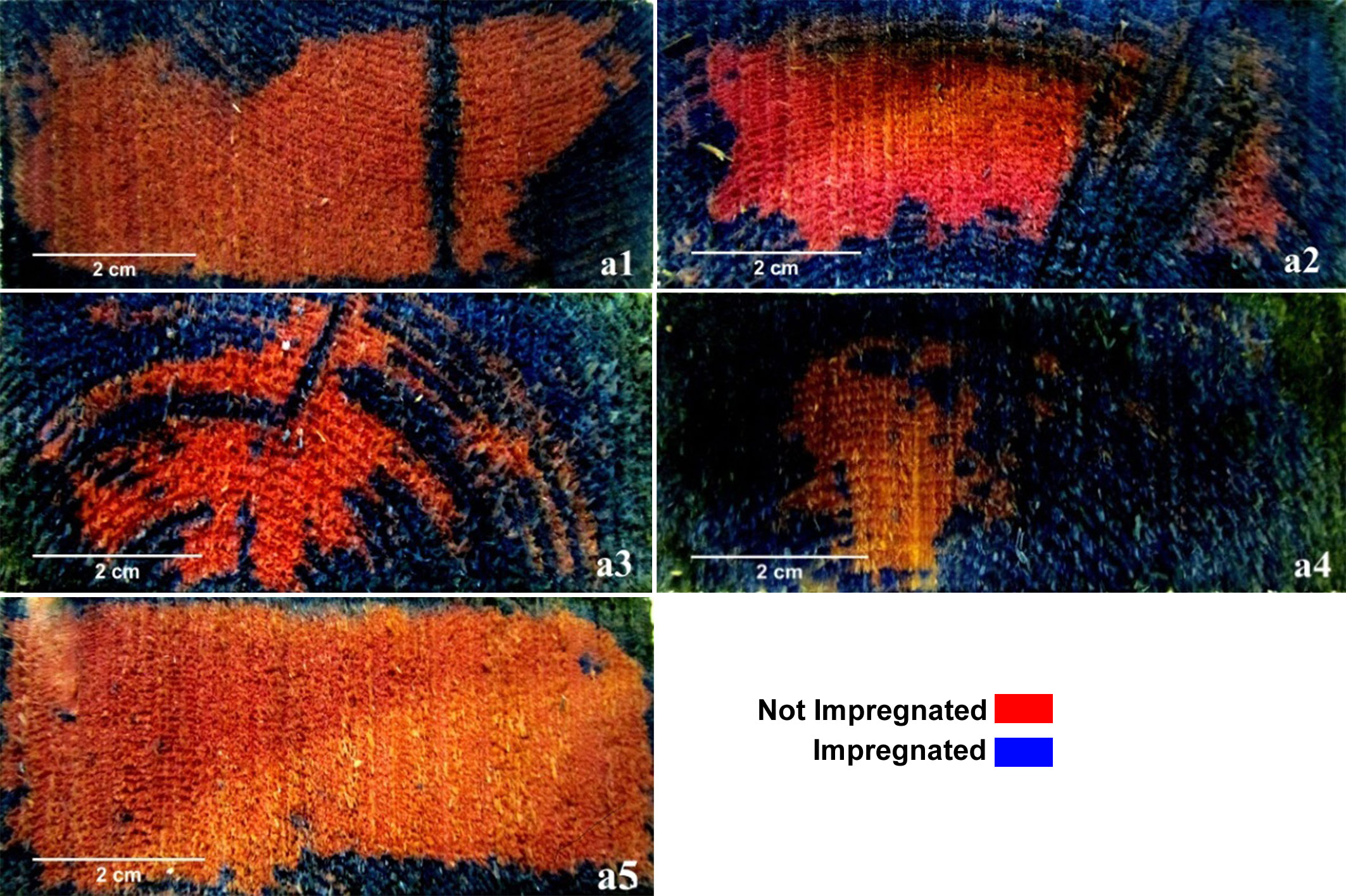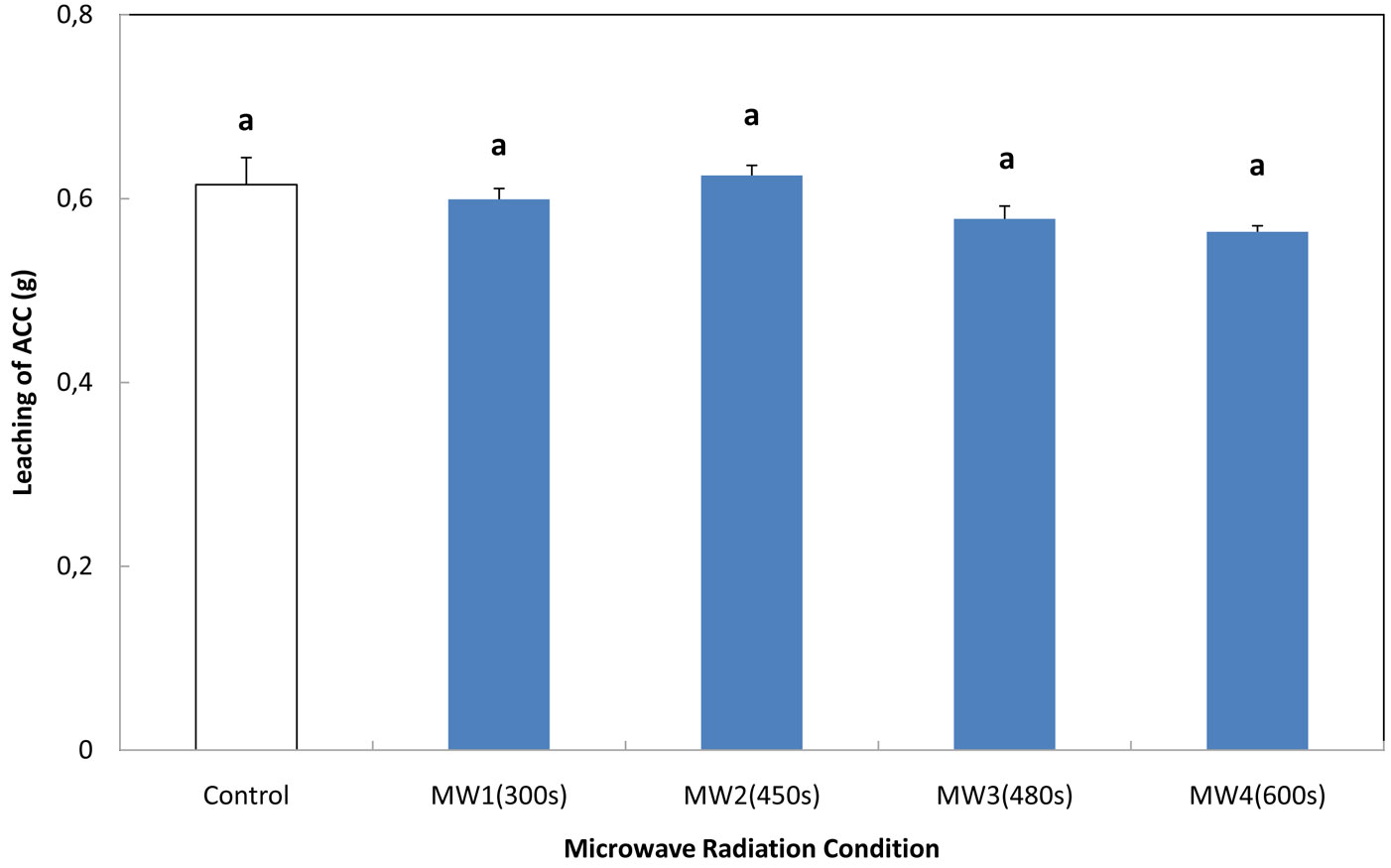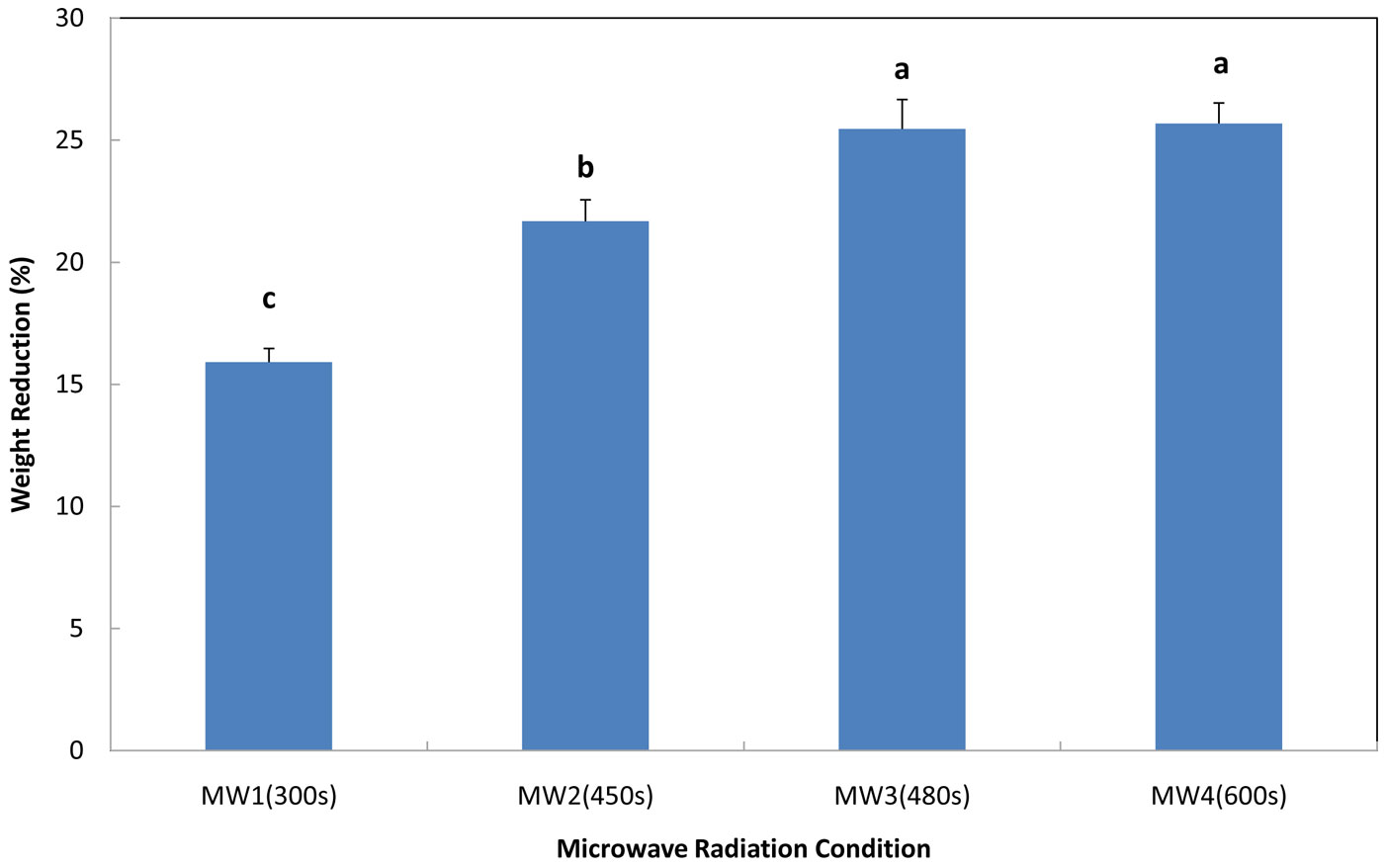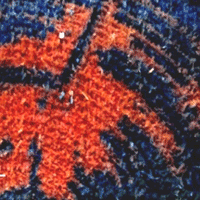
Improving impregnation properties of fir wood to acid copper chromate (ACC) with microwave pre-treatment
iForest - Biogeosciences and Forestry, Volume 8, Issue 1, Pages 89-94 (2015)
doi: https://doi.org/10.3832/ifor1119-007
Published: Apr 01, 2014 - Copyright © 2015 SISEF
Technical Notes
Abstract
Effects of microwave pre-treatment on impregnation properties in fir wood (Abies alba L.) with acid copper chromate (ACC) were studied here. Flat-sawn specimen boards were prepared with moisture content (MC) of 40 ± 5% and were exposed to microwave radiation with 2450 MHz frequency for 10, 12, 14, and 16 minutes at four different radiation treatments. Microwave-treated specimens, along with the control specimens, were conditioned to the final MC of 12% and then impregnated with 5%-ACC solution, using an empty-cell process. The impregnation properties were then measured, including retention, maximum and minimum depths of penetration, impregnated area in the cross-section, and ACC-leaching. Image J software was used to determine depths of penetration. Results showed that microwave pre-treatment significantly improved all the impregnation properties, with the exception of leaching. Clear direct relation was found between the duration of microwave radiation with the properties. It can be concluded that microwave pre-treatment can be used to significantly improve impregnation properties in fir wood.
Keywords
Abies alba, Fir Wood, Impregnation, Microwave Radiation, Pre-treatment
Introduction
Species with low wood permeability, such as fir (Abies alba L.), cause many problems during the wood impregnation process with preservatives. Fir is a gymnosperm species with torus margo pit membrane; the low permeability is mainly due to the pit aspiration during drying. Different modification methods, such as steaming, mechanical incising, drilling techniques and bio-incising were tested to improve the impregnation properties of such refractory wood species ([12], [9], [4]). Microwave (MW) radiation is an innovative method to increase the wood permeability and thus to improve the preservative penetration in the wood of various species ([21], [2], [18], [5]). Due to the high efficiency in converting electricity into microwave radiation, energy saving, in-depth heating of materials and reduced costs, microwave pre-treatment is spreading in many industries ([19]). The increasing effect of microwave radiation on the wood permeability was reported to be due to changes in the wood porous structure ([11], [25], [22]). Torgovnikov & Vinden ([18]) mentioned that when the microwave energy was applied to wood, the steam pressure generated within the wood cells provokes the rupture of the pit membranes on cell walls and the weak ray cells, allowing an easier fluid transfer. Liu et al. ([10]) reported that the permeability of larch wood can be improved without noticeable reduction in the strength and stiffness if the conditions of microwave pre-treatment were optimized. Treu & Gjolsjo ([20]) also reported that the microwave processing of Norway spruce (Picea abies L.) caused a significant increase in the uptake of a 2% copper-based preservative after wood modification by microwave energy of more than 50 kWh/m3 at a frequency of 2.45 GHz. Hong-Hai et al. ([7]) also found that the water uptake of Larch (Larix olgensis) wood irradiated by microwave was 2.5 to 3.3 times greater than that of non-radiated wood. Dashti et al. ([5]) found that the microwave radiation of fir wood (Abies alba L.) at frequency of 2.45 GHz for 7 and 10 minutes can increase the wood radial permeability. They also reported that the torus of some bordered pits was hydrolyzed due to the microwave radiation; however, they did not study the relationship of MW pre-treatment on the amount of preservative uptake, depth of penetration, or other impregnation properties. This species is vastly grown in different parts of the world and therefore provide a continuous raw material for commercial applications; huge amount of fir lumbers are also imported to Iran on a regular basis to satisfy the growing needs for commercial woods. Because of the importance of fir species in timber industry and its various applications, the present research was carried out to evaluate the effects of microwave radiation conditions on the impregnation properties of fir wood (Abies alba L.) with ACC (acid copper chromate) preservative.
Materials and methods
Sampling and microwave pre-treatment
Ten flat-sawn boards of fir wood (Abies alba L.) with green dimensions of 400 × 15 × 5 cm and average moisture content (MC) of 40 ± 5% were used for the study. From each board, five specimens were prepared; one as the control specimen without MW-radiation, and the other four specimens to be MW-radiated under four different MW-treatments. The dimensions of specimens were 250 × 100 × 50 mm. Density of the specimens at moisture content of 8% was 0.32 g cm-3. A domestic Samsung microwave oven (CE3780AT) with frequency of 2450 MHz was used for microwave radiation; the output power was 900 W. Four MW-treatments were used (Tab. 1). The microwave radiation was stopped for 60 to 90 sec (rest time) after every 60 to 150 sec of microwave exposure to prevent cracking due to the rapid wood moisture removal. Specimens were exposed to MW one at a time. The total MW exposure times were 300, 450, 480, and 600 sec for MW1, MW2, MW3, and MW4, respectively. Before and after the MW-radiation, specimens were weighted using a digital scale with 0.01 g precision, in order to measure the reduced weight. Due to hygrome- chanical behavior of wood ([6]), after microwave treatment the samples were conditioned to 12% moisture content at relative humidity of 65% and temperature of 20 °C.
Tab. 1 - Microwave radiation treatments applied to fir wood specimen boards (Abies alba L.).
| Micro-Wave Treatment |
MW power (kW) |
Time of MW power application (s) |
Number of MW power exposures |
Total time of MW exposure (s) |
Energy applied in every exposure (kJ) |
Time of cooling between MW exposures (s) |
Total cooling time (min) |
|---|---|---|---|---|---|---|---|
| MW1 | 0.90 | 60 | 5 | 300 | 54 | 60 | 5 |
| MW2 | 0.90 | 90 | 5 | 450 | 81 | 60 | 5 |
| MW3 | 0.90 | 120 | 4 | 480 | 108 | 90 | 9 |
| MW4 | 0.90 | 150 | 4 | 600 | 135 | 90 | 9 |
Impregnation method
Before impregnation, the samples were end coated using two layers of paraffin to prevent the preservative flow through the longitudinal direction. Samples were then impregnated with ACC, using Rueping method. The used preservative solution was a mixture of Copper Sulfate, Sodium Dichromate and Chromic Acid with concentration of 50%, 48.3% and 1.7%, respectively. The diagram of impregnation process is shown in Fig. 1.
Measuring impregnation properties
After the impregnation, the preservative retention was calculated as follows (eqn. 1):
where R (retention) is the amount of wood preservative retained in the wood specimen (kg of preservative per m3 of wood), Mi is the mass of wood specimen after impregnation (kg), Mn is the mass of wood specimen before impregnation (kg), Vw is the volume of the specimen (m3) and Cp is the concentration of the preservative in the impregnation solution (kg kg-1).
The depth of preservative penetration was measured using Chrome Azurol S (color index No.43825, also known as mordant blue 29) reagent according to AWPA-A3-84 standard ([1]). To prepare this reagent, 0.5 g Chrome Azurol S and 5 g sodium acetate were dissolved in 80 ml distilled water and the solution was diluted to a volume of 300 mL. Then, this reagent was sprayed on the cross section of impregnated specimens. As a result, ACC-impregnated areas appeared in blue color and un-impregnated surfaces changed to red color. Depth of penetration was measured at four different sides in each specimen with a digital caliper with 0.1 mm precision; finally, the maximum and minimum depths of penetration were determined. The impregnation area (%) on the wood cross section was measured by the aid of the software INAHF J. The leaching tests were conducted based on EN-84 standard. Five specimens with dimensions of 50 × 25 × 15 mm were prepared from each treatment and kept in conditioning chamber for 3 weeks (relative humidity of 65 ± 5% at 20 ± 2 °C). Specimens were then placed in a desiccator located in separate test vessels, fitted with a vacuum pump, capable of maintaining a pressure of 4 kPa. Specimens were ballasted with weights to prevent from floating and then flooded with water. Specimens were immersed in water for 14 days. At the end of the first and second day of immersion, water was changed; water was further changed seven times in the remaining 12 days at intervals of two days. For each MW-treatment, five replications were used.
ANOVA was applied to the collected data (α = 0.05) after their normal distribution was verified. The significance of the differences among the means of MW-treatments was tested using the Duncan’s multiple range test by SPSS (v. 2011) software. To summarize the differences among MW-treatments based on more than one property simultaneously, a hierarchical cluster analysis was carried out using the Ward’s method on a squared Euclidean distance matrix.
Results
All the microwave treatments increased the preservative retention in the wood specimens (Fig. 2). The preservative retention was improved by increasing the microwave radiation period from 10 to 16 minutes. However, the difference between non-impregnated wood specimens and those MW-radiated for 10 min was not statistically significant. The preservative retention for the specimens MW-radiated for 16 min was outstanding and ranged from 16.55 to 19.56 (kg m-3). The retention of 16 min MW-radiated specimens was improved by almost 7 times (612%) compared to that for the un-radiated ones. The preservative retention for non-impregnated wood specimens ranged from 1.74 to 2.98 (kg m-3).
Fig. 2 - Acid Copper Chromate (ACC) retention in the microwave radiated and un-radiated wood specimens of fir wood ± SD. Different letters indicate significant differences among the means according to Duncan’s test (N=5).
The preservative penetration through the wood specimens was improved due to microwave exposure and the improvement was remarkable for the samples that were MW-radiated for 14 and 16 min (Fig. 3, Fig. 4). The average maximum depth of preservative penetration at 16 min of radiation was 58.2 mm compared to 13 mm for the un-radiated specimens. The minimum depth of penetration was also improved by almost 4 times (328%) as a result of microwave radiation for 16 min.
Fig. 3 - Maximum depth of ACC penetration (mm) through the microwave radiated and un-radiated wood specimens of fir wood ± SD. Different letters indicate significant differences among the means according to Duncan’s test (N=5).
Fig. 4 - Minimum depth of ACC penetration (mm) through the microwave radiated and un-radiated wood specimens of fir wood ± SD. Different letters indicate significant differences among the means according to Duncan’s test (N=5).
Preservative penetrated along the ray cells easily reached the central parts of the MW-radiated specimens (Fig. 5). In the control specimens though, no penetration along the ray cells was observed. The significant effect of MW-radiation on penetration of preservative to the central parts of specimens was quite obvious through the measurement of the impregnated area on the cross-sections of specimens (Fig. 6); the impregnated area was the lowest in the control specimens in comparison to other treatments.
Fig. 5 - Cross-section of impregnated samples, (a1): MW1; (a2): MW2; (a3): MW3; (a4): MW4; (a5): control.
Fig. 6 - Impregnated area (%) measured at the cross-sectional view of the specimens cut from the middle ± SD. Different letters indicate significant differences among the means according to Duncan’s test (N=5).
There was no significant difference in the leaching of ACC preservative between MW-radiated and un-radiated specimens (Fig. 7). However, the amount of leaching tended to decrease as the MW-energy increased (refer to Tab. 1). The lowest leaching were observed in MW3 and MW4, although not significantly different from other MW-radiated or the control specimens. The increase in MW also increased the amount of the reduced weight (Fig. 8). In fact, the reduced weight increased as the MW-energy increased. The highest reduced weights were observed in MW3 and MW4 treatment.
Fig. 7 - ACC leaching from the microwave radiated and un-radiated wood specimens of fir wood ± SD. Different letters indicate significant differences among the means according to Duncan’s test (N=5).
Fig. 8 - Reduction in the weight of specimens after the microwave radiation in comparison to their initial weight (before MW-radiation) ± SD. Different letters indicate significant differences among the means according to Duncan’s test (N=5).
Cluster analysis, based on all the impregnation properties measured in the present study (retention, maximum and minimum depths of penetration, impregnated area in the cross-section, and ACC leaching) showed that microwave pre-treatments for 14 and 16 minutes were significantly grouped (Fig. 9), while pre-treatments of 10 and 12 minutes were closely clustered to the control specimens.
Fig. 9 - Cluster analysis of different treatments based on all the impregnation properties ± SD (retention, maximum and minimum depths of penetration, impregnated area in the cross-section, and ACC leaching).
Discussion
The retention of 16 min MW-treated specimens was improved by almost 7 times compared to that of the un-radiated ones. This improving effect caused by MW-treatment was also reported by Treu & Gjolsjo ([20]) for Norway spruce (Picea abies). Hong-Hai et al. ([7]) also found that the water uptake of Larch (Larix olgensis) wood radiated by microwave was 2.5 to 3.3 times greater than that of the un-radiated wood. The effect of MW on the preservative retention can be attributed to ray cell rupture. The effect of MW on preservative penetration can also be attributed to a radial wood permeability improvement as reported by Dashti et al. ([5]). The ruptures in the ray parenchyma caused by the microwave radiation facilitated the penetration of preservative. In fact, penetration of any kinds of fluid into a porous media is directly related to its structure ([15]); therefore, any small alterations in the porous structure by pressure ([13]), heat ([8]), or cold ([14]) would significantly change the permeation properties. Moreover, the maximum weight reduction by microwave treatment occurred in MW4; consequently, it can be inferred that the maximum shrinkage and widening of pits was also happened in this treatment. Ultimately, this widening of pits resulted in a significant improvement in penetration of ACC. The radial permeability of softwood is significantly controlled by ray parenchyma rather than by bordered pits ([16]). Previous studies have shown that the permeability of some wood species in the radial direction can be increased by 170-1200 times due to microwave radiation ([17]). Results of Image J software studies also showed that the impregnation amount on the cross section increased due to microwave radiation; the greatest improvement was observed for specimens radiated for 16 min.
Results of the present study showed that the effect of microwave pre-treatments on leaching of ACC as a water-based preservative was not statistically significant. However, the increasing effects of microwave post-treatment on leaching resistance of copper-based preservatives were previously reported ([24], [3], [23]). Therefore, further complementary studies should be done to understand these contradictions. In the meantime, a fixation method is recommended to be applied to prevent the preservative from leaching.
Cluster analysis, based on all the impregnation properties measured in the present study showed that microwave pre-treatments for 14 and 16 minutes were significantly grouped. So, from an economical point of view, microwave pre-treatment of 14 minutes may be recommended due to the shorter time and thus lower costs. Furthermore, pre-treatments of 10 and 12 minutes were closely clustered to the control specimens. It can then be concluded that these two exposure time may not be recommended. As the difference between MW2 and MW3 was only 2 minutes, it may be concluded that the critical point was between 12 and 14 min of microwave exposure. Further studies on optimal time-intervals as well as on mechanical properties are recommended.
References
Gscholar
Gscholar
Gscholar
Gscholar
Gscholar
Gscholar
Gscholar
Gscholar
Gscholar
Gscholar
Gscholar
Gscholar
Authors’ Info
Authors’ Affiliation
Faculty of Natural Resources, University of Tehran, Tehran (Iran)
Department of Wood and Paper Science & Technology, Faculty of Natural Resources, University of Tehran, Tehran (Iran)
Wood Science and Technology Department, Faculty of Civil Engineering, Shahid Rajaee Teacher Training University, Tehran (Iran)
Corresponding author
Paper Info
Citation
Ramezanpour M, Tarmian A, Taghiyari HR (2015). Improving impregnation properties of fir wood to acid copper chromate (ACC) with microwave pre-treatment. iForest 8: 89-94. - doi: 10.3832/ifor1119-007
Academic Editor
Elena Paoletti
Paper history
Received: Sep 07, 2013
Accepted: Nov 11, 2013
First online: Apr 01, 2014
Publication Date: Feb 02, 2015
Publication Time: 4.70 months
Copyright Information
© SISEF - The Italian Society of Silviculture and Forest Ecology 2015
Open Access
This article is distributed under the terms of the Creative Commons Attribution-Non Commercial 4.0 International (https://creativecommons.org/licenses/by-nc/4.0/), which permits unrestricted use, distribution, and reproduction in any medium, provided you give appropriate credit to the original author(s) and the source, provide a link to the Creative Commons license, and indicate if changes were made.
Web Metrics
Breakdown by View Type
Article Usage
Total Article Views: 57979
(from publication date up to now)
Breakdown by View Type
HTML Page Views: 46545
Abstract Page Views: 3103
PDF Downloads: 6297
Citation/Reference Downloads: 18
XML Downloads: 2016
Web Metrics
Days since publication: 4291
Overall contacts: 57979
Avg. contacts per week: 94.58
Article Citations
Article citations are based on data periodically collected from the Clarivate Web of Science web site
(last update: Mar 2025)
Total number of cites (since 2015): 20
Average cites per year: 1.82
Publication Metrics
by Dimensions ©
Articles citing this article
List of the papers citing this article based on CrossRef Cited-by.
Related Contents
iForest Similar Articles
Research Articles
Improving dimensional stability of Populus cathayana wood by suberin monomers with heat treatment
vol. 14, pp. 313-319 (online: 01 July 2021)
Research Articles
Reversible and irreversible effects of mild thermal treatment on the properties of wood used for making musical instruments: comparing mulberry to spruce
vol. 15, pp. 256-264 (online: 20 July 2022)
Review Papers
Wood modification technologies - a review
vol. 10, pp. 895-908 (online: 01 December 2017)
Research Articles
Kinetic analysis of poplar wood properties by thermal modification in conventional oven
vol. 11, pp. 131-139 (online: 07 February 2018)
Short Communications
Changes in Populus sp. wood subjected to heat treatment: anatomy and silica content
vol. 18, pp. 223-226 (online: 09 August 2025)
Research Articles
Pre-treatment with sodium silicate, sodium hydroxide, ionic liquids or methacrylate resin to reduce the set-recovery and increase the hardness of surface-densified Scots pine
vol. 10, pp. 857-864 (online: 26 October 2017)
Research Articles
Dielectric properties of paraffin wax emulsion/copper azole compound system treated wood
vol. 12, pp. 199-206 (online: 10 April 2019)
Research Articles
Physical and mechanical characteristics of poor-quality wood after heat treatment
vol. 8, pp. 884-891 (online: 22 May 2015)
Research Articles
NIR-based models for estimating selected physical and chemical wood properties from fast-growing plantations
vol. 15, pp. 372-380 (online: 05 October 2022)
Research Articles
Identification of wood from the Amazon by characteristics of Haralick and Neural Network: image segmentation and polishing of the surface
vol. 15, pp. 234-239 (online: 14 July 2022)
iForest Database Search
Search By Author
Search By Keyword
Google Scholar Search
Citing Articles
Search By Author
Search By Keywords
PubMed Search
Search By Author
Search By Keyword

